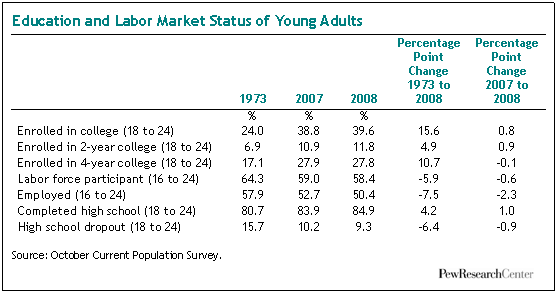I. Overview
The share of 18- to 24-year-olds attending college in the United States hit an all-time high in October 2008, driven by a recession-era surge in enrollments at community colleges, according to a Pew Research Center analysis of newly released data from the U.S. Census Bureau.
Just under 11.5 million students, or 39.6% of all young adults ages 18 to 24, were enrolled in either a two- or four-year college in October 2008 (the most recent date for which comprehensive nationwide data are available). Both figures — the absolute number as well as the share — are at their highest level ever.
Enrollments have been rising over many decades at both two- and four-year colleges, but the most recent annual spike has taken place entirely at two-year colleges.
In October 2007, some 3.1 million young adults, or 10.9% of all 18- to 24-year-olds, were enrolled in a community college.1 A year later, that figure had risen to 3.4 million students, or 11.8% of all 18- to 24-year-olds. By contrast, enrollments at four-year colleges were essentially flat from 2007 to 2008.
This new peak in college enrollment has come in the midst of a recession that has driven the national unemployment rate to its highest level in more than a quarter of a century and has had an especially harsh impact on young adults. According to the Bureau of Labor Statistics, a smaller share of 16- to 24-year-olds were employed in September 2009 — 46.1% — than at any time since the government began collecting such data in 1948.
Community college enrollments have long been considered somewhat countercyclical; that is, they tend to rise as the economy worsens (Betts and McFarland, 1995). One reason is that community colleges are less expensive than four-year institutions — they average $6,750 per year (including tuition, fees, and room and board) in the net price for full-time students, compared with $9,800 for four-year public colleges and $21,240 for four-year private colleges (College Board, 2009).2
Despite the higher costs of four-year institutions, their enrollments have not dropped during this recession. Rather, they have held steady — and have been able to do so despite tuition increases averaging 4.9% per year beyond general inflation from 1999-2000 to 2009-10 at public four-year colleges and universities (College Board, 2009).
Changes in the labor market and the overall economy are not the only factors that affect college enrollment levels. Another important factor is the rate at which young adults complete high school. Here, too, Census Bureau data show that a new milestone has been reached.

According to census figures, a record 84.9% of 18- to 24-year-olds had completed high school as of October 2008, up from 75.5% in 1967 and 83.9% in 2007. Along these same lines, there is a record low in the share of young adults who are high school dropouts — 9.3% in 2008, less than half the figure (19.8%) in 1967 and down nearly a percentage point from 10.2.% in 2007.
About this Report
This report is primarily based on the Pew Research Center’s analysis of the October 2008 Current Population Survey and Census Bureau’s historical time series on college enrollment available on the Census Bureau’s website. The charts were prepared by research associate Wendy Wang. The historical tables in the Appendix were formatted by research assistant Daniel Dockterman. Paul Taylor, director of the Pew Research Center’s Social & Demographic Trends project, provided editorial guidance and wrote the overview. Senior researcher Rakesh Kochhar provided helpful insights on the use of the Current Population Survey. Research analyst Gabriel Velasco did the number checking, and Marcia Kramer copy-edited the report.




